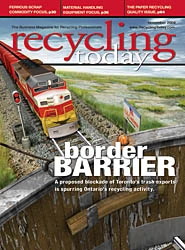Those who think that the Paris-to-Dakar trans-Sahara road rally is a test of man and machine should check out what is happening with skid-steer loaders working in recycling applications.
Nearly every recycling company uses skid steers and/or forklifts in some aspects of its operation. While moving bales or pallets of sorted materials; pushing material onto a pit conveyor; or sorting and arranging material on the tipping floor of a MRF or paperstock plant, the loader moves over broken glass, shredded metals and other sharp objects.
Downtime is expensive. That is why management at Midland-Davis Corp., Moline, Ill., encourages its skid-steer operators to take a machine to the shop and have the mechanics take a look at it if they even think something could be wrong with it, Mitch Davis, vice president of operations, says. "That eliminates things getting out of hand."
|
UNDER CONTRACT |
|
It is usually cost ineffective to do major work on a machine that is under warranty. However, most recyclers with in-house mechanics see little value in extending the maintenance agreements beyond the warranty period. Mitch Davis of Midland-Davis Corp., Moline, Ill., says the relatively inexpensive service contracts available on some fork trucks are among the exception. "They are not that expensive and often are worth it," he says. Is it "overkill" to have in-house maintenance personnel and a contract with a dealership for maintenance? Kelli Bashore of Caterpillar Inc. notes that the company’s dealers have on-site preventive maintenance programs that can provide a great benefit to recyclers. "It is still very important for recyclers to remain vigilant of maintenance issues that may arise," Bashore says, emphasizing the importance of proper maintenance to the life of a machine. "If it requires both in-house maintenance and dealership maintenance to do this, then it cannot be considered overkill," Bashore says. |
Every part of the machine—cooling system, tires, hydraulics, even the forks—needs TLC to function reliably.
Responsibility is a byword at Midland-Davis and other yards. "I’ve always found that, rather than letting the operators get on any machine, assigning one man to one machine works better," Davis continues.
The operator runs the same unit every day and gets used to the peculiarities of the machine. "They know they have to check the fluid levels before starting. In the winter, they let it warm up before using it."
A CLEAN MACHINE. "Dust is the biggest problem we have with our machines," says Michael Benedetto, vice president of TFC (Tidewater Fibre Corp.) Recycling, Chesapeake, Va. "With the environment we are in, we always do extra preventive maintenance," he says. "We change the filters, we clean the equipment."
That’s a good start, equipment manufacturers agree. "Improper methods of operation and maintenance of skid-steer loaders are the leading cause of downtime," says Sanford N.C.-based Kelli Bashore, skid-steer loader marketing representative for Caterpillar. In recycling yards this is especially true, because of the corrosive nature of the materials these machines encounter on a daily basis.
"It is important to clean your machines on a regular basis to prevent a build-up of materials both inside the engine compartment and around the axles," Bashore says.
Cat offers special debris guarding kits that help to prevent debris from entering cylinders, air intakes, etc.
At TFC, the mechanics in the shop, not the equipment operators, are responsible for maintenance. It is done on a regularly scheduled basis, either on a given day each week, at the start of the night shift or whenever appropriate.
"The shop blows out all the areas where there is air intake. We change filters more often than the manual recommends," Benedetto says.
Davis also is a big believer in keeping machines clean. "You’re never that busy that you can’t take an air hose and blow off the radiator," he says. Especially in the paper plants, it is important to keep the air intake areas free of litter.
"Regular service at regular intervals works," Davis says. "Sometimes you can get outfoxed by a machine," he admits. "That’s why we have a maintenance facility here."
Midland-Davis does all of its work in house unless the machine is under warranty. Because the company has a paper processing facility and a scrap yard, it has plenty of equipment. In addition to the usual collection of trucks, Midland-Davis has four forklift trucks, a mini-loader, skid steers and a large loader for its wood chipping operation.
TFC also tries to do as much work in house as possible. "When we get in over our heads, we go to the manufacturer," Benedetto says.
The experts say standardizing to one brand of skid-steer loader offers maintenance advantages, especially if the owner is planning on maintaining the machines in house. "It is easier to remember maintenance intervals for one type of machine than it is to remember several," says Bashore. However, the choice of skid-steer loader or forklift models depends on the needs of the owner. "Some owners may need several model sizes within different classes depending on the needs of their yard."
"Having a fleet of equipment that is of one brand provides many advantages like commonality of fluids, oils and filters," says Larry Foster, product manager with John Deere Co., Moline, Ill. "This reduces the customer’s parts inventory complexity."
Foster says that common parts and components help to make life easier for the in-house service tech. "Technical training is easier because components and systems may be common or similar between products," he adds.
COOL RUNNING. One of the most important maintenance tasks is keeping the cooling systems clean to ensure engine, transmission and hydraulics always are operating within the correct temperature range, Foster says. "Overheating these systems reduces the life of components and can result in downtime later on in the machine’s life," he says.
Sponsored Content
Labor that Works
With 25 years of experience, Leadpoint delivers cost-effective workforce solutions tailored to your needs. We handle the recruiting, hiring, training, and onboarding to deliver stable, productive, and safety-focused teams. Our commitment to safety and quality ensures peace of mind with a reliable workforce that helps you achieve your goals.
Sponsored Content
Labor that Works
With 25 years of experience, Leadpoint delivers cost-effective workforce solutions tailored to your needs. We handle the recruiting, hiring, training, and onboarding to deliver stable, productive, and safety-focused teams. Our commitment to safety and quality ensures peace of mind with a reliable workforce that helps you achieve your goals.
Sponsored Content
Labor that Works
With 25 years of experience, Leadpoint delivers cost-effective workforce solutions tailored to your needs. We handle the recruiting, hiring, training, and onboarding to deliver stable, productive, and safety-focused teams. Our commitment to safety and quality ensures peace of mind with a reliable workforce that helps you achieve your goals.
Sponsored Content
Labor that Works
With 25 years of experience, Leadpoint delivers cost-effective workforce solutions tailored to your needs. We handle the recruiting, hiring, training, and onboarding to deliver stable, productive, and safety-focused teams. Our commitment to safety and quality ensures peace of mind with a reliable workforce that helps you achieve your goals.
Sponsored Content
Labor that Works
With 25 years of experience, Leadpoint delivers cost-effective workforce solutions tailored to your needs. We handle the recruiting, hiring, training, and onboarding to deliver stable, productive, and safety-focused teams. Our commitment to safety and quality ensures peace of mind with a reliable workforce that helps you achieve your goals.
Sponsored Content
Labor that Works
With 25 years of experience, Leadpoint delivers cost-effective workforce solutions tailored to your needs. We handle the recruiting, hiring, training, and onboarding to deliver stable, productive, and safety-focused teams. Our commitment to safety and quality ensures peace of mind with a reliable workforce that helps you achieve your goals.
Sponsored Content
Labor that Works
With 25 years of experience, Leadpoint delivers cost-effective workforce solutions tailored to your needs. We handle the recruiting, hiring, training, and onboarding to deliver stable, productive, and safety-focused teams. Our commitment to safety and quality ensures peace of mind with a reliable workforce that helps you achieve your goals.
Some manufacturers, including Deere, have automatic reversing fans on wheel loaders and crawlers to blow the trash out of coolers. Skid steers have easy swing-out coolers in the door.
Elimination of certain service tasks or reduction in the frequency helps shorten the operating chore list. "Use of serpentine auto tension belts and extended service intervals for the engine oil and filters are some examples," he says.
Benedetto says the installation of rubber strips on its loader blades has extended the life of the machinery and preserved the grounds.
"We contacted the manufacturer for rubber under-blades," he continues. TFC also paid extra for a special, abrasion-resistant concrete for the pad. This combination of ideas seems to be working.
Dust, sharp metal, wire, string and other materials can all shorten the life span of a skid steer. Bashore says Caterpillar has designed an axle to combat these harmful contaminants. "Our skid-steer loaders feature a high-tech triple lip seal, which protects axle bearings from contamination and premature axle failure," Bashore says.
In unheated facilities it is important for the operator to allow the machine’s engine and hydraulic oils to warm up in cold temperatures. The cooling package that Cat offers helps the operator to prevent overheating in hot temperatures. The hydraulically driven fan continues to cool even in low rpm.
"Ensuring the unit never exceeds its operating temperature range will help immensely in preventing down time," Foster says. "Clean coolers are one key. Keeping fluid levels in the operating range is the other."
He adds, "If you make it easy, operators almost always maintain their equipment. However, if you make it hard or inconvenient to clean the coolers and operators may not always perform proper and timely cleaning of the coolers."
The author is a Recycling Today contributing editor based in Cleveland. He can be contacted at curt@curtharler.com.
Get curated news on YOUR industry.
Enter your email to receive our newsletters.

Explore the November 2004 Issue
Check out more from this issue and find your next story to read.
Latest from Recycling Today
- ReMA opposes European efforts seeking export restrictions for recyclables
- Fresh Perspective: Raj Bagaria
- Saica announces plans for second US site
- Update: Novelis produces first aluminum coil made fully from recycled end-of-life automotive scrap
- Aimplas doubles online course offerings
- Radius to be acquired by Toyota subsidiary
- Algoma EAF to start in April
- Erema sees strong demand for high-volume PET systems






